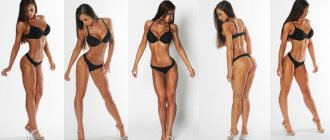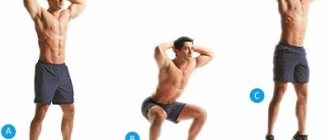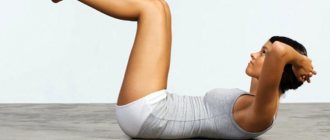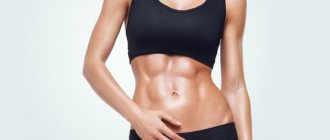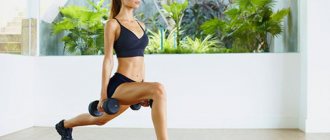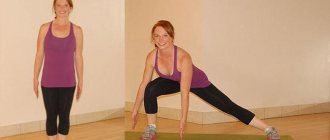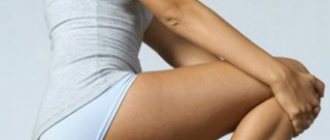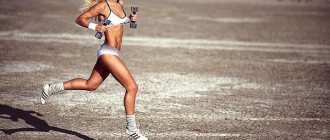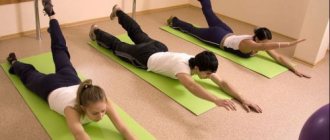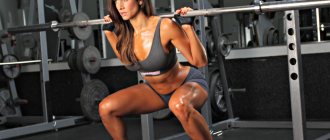According to statistics, the first thing men pay attention to is their buttocks. Some people are given this from birth, but other girls will have to put in a lot of effort to get a good result. To do this, you need to take the matter seriously and prepare for regular training.
Every girl wants to have a beautiful, toned butt and protect herself from cellulite, but not many have a lot of free time, money and the desire to go to the gym or, moreover, to a professional trainer. In this article we will tell you how to achieve beautiful shape at home, tell you about the 30 best exercises at home and offer 7 excellent training programs for an easy start.
Yes, there are many factors working against us girls that are responsible for the deterioration in the appearance of the butt:
- sudden weight loss or weight gain
- passive lifestyle
- bad habits
- lack of sports..
All this leads to sagging buttocks and the formation of cellulite.
However, there is good news. All you need, the only immutable and simple condition for correcting this situation, is your sincere desire to start training! You just need good music in headphones and a fighting mood.
Everything else: the right training program, a balanced diet, and even time for training - these are technical questions that you can easily find answers to on our website. You can always check out the latest exercises for the buttocks and butt and start creating your own unique training program every day.
Anatomy of the gluteal muscles
If you decide to get serious about your butt, you should remember that squats are the foundation for beautiful butts! You can do as many different exercises as you like, but squats give them a toned shape. To better understand the issue, let's look at the structure of the gluteal muscles.
The gluteal muscles of the body are 3 paired muscles: gluteus maximus, gluteus medius and minimus.
How to make your butt big and pumped up
It is known that there is such an irresistible thing as hereditary predisposition. If a woman has a narrow pelvis, then training will not make it wider. And vice versa, if a man’s pelvis is wider than he would like, not a single gym will be able to narrow it. The shape of the butt depends mainly on the parameters of the gluteus maximus muscle, quite a bit - on the middle muscle, and practically does not depend on the gluteus minimus muscle. By the way, the length and width of the muscle cannot be changed either - genetics does not allow it. But you can pump up your butt and remove excess fat. That is, to a certain extent, increase muscle mass and “dry out” excess deposits. But everything is good in moderation: one admires elasticity, not thinness; Flabbiness is what disgusts, not fullness.
It is impossible to get an attractively shaped butt, although you can inherit it, but it won’t last long. The most reliable way is training. Moreover, to get a beautiful butt, experts advise pumping the upper, lower and lateral sectors of the buttocks separately. This allows you to form the surface with great precision, hide imperfections and bring the shape closer to the ideal. Next, we will look in detail at how to change specific areas of the buttocks.
Bodymaster.ru recommends Training Plans:
The large muscle is the largest muscle of the whole body, it works in cooperation with the gluteus minimus and performs the function of extension, abduction and rotation of the hip. It is also this muscle that is responsible for the volume of the buttocks.
The gluteus medius muscle is located on the outside of the pelvis and is responsible for keeping our pelvis in a stable position when walking. The minimus muscle is located below the gluteus medius muscle. It also helps you maintain balance.
Your overall physical condition, strength and endurance depend on the gluteal muscles, so you must always keep them in good shape. Find out how much it takes to pump up your buttocks in any conditions. Especially with a sedentary lifestyle, it is advisable to take daily walks and do light bodyweight training.
An example of such a simple workout can be the following 3 exercises in a circular performance in any combination from one of the fastest female trail runners in the World - Ekaterina Mityaeva:
- Bodyweight Lunges to the Side
- Bodyweight forward lunges
- Back lunges into scissors
And now to the most delicious topic - protein and low-calorie diets.
Butt workout for beginners
If you have little experience in fitness, then it is recommended to start training to pump up your gluteal muscles with simple exercises. This will allow you to set up equipment, which will protect your joints when moving on to more serious loads. Beginners should exercise without weights, so you can safely perform buttock exercises even at home.
If necessary, you can optimize the training to suit your capabilities:
- divide the exercises into two days;
- reduce the number of repetitions or approaches;
- Avoid exercises that cause discomfort.
Side step squat
How to do it: Take a starting stance - stand straight, place your feet next to each other, clasp your hands with your palms in front of your chest, and keep your elbows near your body. Then take a step to the right half a meter. Lower your pelvis until your thighs are parallel to the floor, but do not bring your knees beyond your toes and point them forward. Do not tilt your back too much, maintain a slight arch in the lower back. Come back and repeat on the other side.
What are the benefits: Modeling the shape of the buttocks, reducing the fat layer on the hips and under the butt, showing muscle definition. The ankles and joints are strengthened, the ligaments become more elastic. As a result of performing this exercise on the buttocks for beginners, the muscles are filled with blood, increasing elasticity.
- For beginners:
10 squats (5 squats on each leg) in 2 sets - For intermediate level: 16 squats (8 squats on each leg) in 3 sets
Reverse lunges
How to do it: Stand in a classic stance - spread your feet shoulder-length apart, and place your arms on your sides. Step your foot back, plant your toes, and lower your pelvis into a lunge. Keep the knee joints of both legs at a right angle, and lower the front thigh to parallel with the floor. Do not bend your body, look forward. Do not extend the knee of the supporting leg beyond the toe. Stand back up. First, do the required number of lunges with your left leg, then with your right.
How to do reverse lunges
What are the benefits: Loading the gluteus maximus and quadriceps muscles, giving athletic shape and fit. Also works your calves, hamstrings, back extensors and core. The elasticity of muscle fibers develops, stabilizers are strengthened. Basic glute exercise for beginners.
- For beginners:
10 lunges on each leg in 2 sets - For intermediate level: 15 lunges on each leg in 3 sets
"Good morning"
How to do it: Take the classic position - stand with your feet shoulder-width apart. Raise your arms up and clasp your head with your palms from behind, and point your elbows to the sides. Shift your center of gravity slightly to your heels. Start by moving your pelvis back and simultaneously leaning your body forward. Bend your knees slightly, bring your torso parallel to the floor. Move your buttocks back as far as possible. Keep a natural arch in your back. Get up.
What are the benefits: Stretching and pumping the gluteal muscles and hamstrings, strengthening the hamstrings. The back extensors are loaded, the lower back is actively involved in the work, which allows you to strengthen the core and straighten your posture. When performed regularly, progress in strength lifting is noted.
- For beginners:
10 reps in 2 sets - For intermediate level: 15 repetitions in 3 sets
Sumo squats
How to do it: This glute exercise for beginners is a variation of the classic squat, but with more emphasis on the glutes. The difference is in the positioning of the legs, emphasis on muscle groups. Spread your feet as far apart as possible, turn your toes to the sides, clasp your hands in front of your chest. Lower your pelvis, bring your thighs parallel to the floor. Do not bend your knees and keep them turned towards your toes. Do not bend your back too much, look forward.
How to do a sumo squat
What are the benefits: Increased involvement of the gluteal muscles in work, pumping the inner thigh. Blood flow to the pelvic organs and legs is activated. Some of the load is removed from the lower back. Mobility and flexibility of the hip joints develops.
- For beginners:
10 squats in 2 sets - For intermediate level: 15 squats in 3 sets
Leg swing on all fours
How to do it: Get into a position on all fours - elbows straight, palms shoulder-width apart, hips perpendicular to the floor, knees at a right angle. Don't slouch your back, keep your spine straight. Look down, slightly in front of you. Without changing the position of your leg, lift it slightly above the parallel of your thigh and the floor, the heel should point clearly upward. Lower to the starting position.
What are the benefits: Active contraction of the gluteal muscles, development of fit and elasticity, strengthening of the hamstrings. The flow of blood and lymph to the working area is stimulated, cellulite is smoothed. The shape of the hips is improved by pumping the adductor muscles. The joints and spine relax.
- For beginners:
10 swings on each leg in 2 sets - For intermediate level: 15 swings on each leg in 3 sets
Swing a straight leg diagonally
How to do it: Take a normal pose on all fours - hips and arms are perpendicular to the floor, knees are at a 90-degree angle, and toes are extended. Straighten your right leg, bring it behind your left shin, and leave it a little further to the side. Next, swing diagonally to the right and up, return your leg back. Keep your back slightly arched, do not wiggle your body. Tighten your glute.
What are the benefits: Rounding the buttocks, giving shape, elasticity, burning fat on the hips and under the butt. The adductor muscles are loaded and tone returns. The outer side of the thighs, where fatty tissue accumulates, works. Performing this buttock exercise at home will help remove cellulite.
- For beginners:
10 swings on each leg in 2 sets - For intermediate level: 15 swings on each leg in 3 sets
Fire hydrant
How to do it: Take a classic position on all fours - hands clearly under your shoulders, hips perpendicular to the surface, knees at a right angle. When performing the swing, do not turn your pelvis or twist your body. Move your leg, left bent at the knee, straight to the side until your thigh is parallel to the floor. Tighten your buttock. Return to the starting position without fully relaxing the muscle.
What is the benefit: Working on the middle gluteal bundle. The large and small muscles receive slightly less load. The outer surface of the thighs is loaded, which stimulates the flow of lymph and blood, smoothes the skin, and eliminates cellulite. The work includes the abs, arms and shoulders, which helps strengthen the muscles.
- For beginners:
10 raises on each leg in 2 sets - For intermediate level: 15 raises per leg in 3 sets
Gluteal bridge
How to do it: Lie on your back, place your arms at your sides and point slightly to the sides. Bend your knees, move them towards your buttocks and place them on your heels. The main movement is to lift the pelvis up until one line is formed from the knees, hips to the stomach and sternum. At the top point, tighten and contract your gluteal muscles. Lower yourself back down. Press your head and neck to the floor.
What are the benefits: Increased development of muscle bundles, rounding, lifting the buttocks, strengthening the core and back. Increases strength and endurance of muscle fibers. Posture improves. Part of the load is removed from the lower back, and tension in the spine is reduced. This is a basic glute exercise for beginners.
- For beginners:
10 lifts in 2 sets - For intermediate level: 15 lifts in 3 sets
Glute bridge with leg swings
How to do it: Lie down and position your legs and arms as you would for a regular glute bridge. Raise your pelvis and maintain this position. Swing your legs alternately, straightening your knee. Keep a single line from chest to hips. Bring your working leg up to it. Keep your toe perpendicular to your shin. Tighten your abs and buttocks. Press your head down. Do not change the position of the body and neck.
What are the benefits: Accented work of the gluteal muscles due to holding a static position, training of the thigh quadriceps. Pain in the knees and lower back is reduced, the back muscles, abs and core are strengthened. Blood flow to the pelvis increases, which improves the functions of internal organs. A whole complex of muscles is involved in the work, which determines the benefits of exercises for the buttocks for beginners.
- For beginners:
10 raises on each leg in 2 sets - For intermediate level: 15 raises per leg in 3 sets
Leg raises while lying on your stomach
How to do it: Lie on your stomach, stretch your legs, cross your arms at your forearms, place your palms above your elbows, and rest your head. Bend one leg at the knee, bring it to a 90-degree angle, and point your heel up. Place your other leg on your toes and keep it straight. By tensing your buttocks, lift the thigh of your bent leg without changing the position of your knee. Lower, repeat again.
What is the benefit: Accented training of the gluteal muscles and hamstrings. The thickness of the fat layer decreases, and the butt is pulled up. During execution, the back extensor muscles are activated. The core and lower back are strengthened. An excellent exercise for the buttocks at home.
- For beginners:
10 raises on each leg in 2 sets - For intermediate level: 15 raises per leg in 3 sets
Will exercises at home get rid of cellulite?
Cellulite is a problem for many women. Its development begins in adolescence, when a girl’s body begins to produce more and more female hormones. The proliferation of adipose tissue disrupts blood microcirculation in the lower part of the body, which triggers local inflammation. Genetic factors also play a major role in the localization of fat deposits in the buttocks.
Is it possible to get rid of cellulite by training your legs or buttocks separately? Scientists have not been able to confirm that fat can be removed in certain areas by working with the underlying muscles. However, experts make two strong arguments for the ability to burn fat in specific areas with strength training and cardio exercises:
- Modern research shows that exercise speeds up the use of fat covering working muscles as fuel.
- Muscle contractions speed up the flow of blood within the fat deposits surrounding the working muscles. This speeds up the process of local release of fat in these areas, while preventing the accumulation of fat .
An increase in blood flow in adipose tissue activates the process of local release of fat, while a decrease in blood flow in adipose tissue promotes the growth of fat deposits. Thus, frequent training of one muscle group not only prevents local hypertrophy of adipose tissue, but also promotes the process of releasing it in target areas.
The exercises discussed in the material against cellulite on the thighs and buttocks will definitely help you launch the necessary metabolic processes. However, it should be noted that fat burns very slowly. You need to prepare for the fact that you will see results only in weeks or even months. The process will go faster if you adhere to a low-calorie diet.
How to tighten your lower buttocks
Muscles need tone, otherwise, when the load decreases, they become flabby and begin to sag. The reason for this may be not only the cessation of training that has already become habitual, but also the emergence of bad habits, a predominantly sedentary lifestyle, and a sharp change in weight.
How to tighten your butt from below? In short, by eliminating the causes of sagging soft tissues:
- remove excess fat;
- move more;
- leave bad habits;
- restore training.
These measures are usually sufficient. However, if you urgently need to tighten the bottom of your buttocks, then we recommend using strength exercises and specific walking:
- deep lunges with dumbbells - keep your back vertical;
- squats with dumbbells with legs wide apart;
- deadlift with dumbbells;
- walking uphill.
The last of the proposed exercises is best performed on a treadmill or on an ellipsoid, setting the inclination angle to at least 9–12%. The weight of dumbbells, the number of repetitions and approaches are indicated in the table at the beginning of the article. As you can see, making your butt big and pumped up is a doable task, and you can handle it.
Basic exercises for growing gluteal muscles
Let's look at a few key types of exercises that will help you effectively work out your beautiful legs at home.
Bodyweight squats
The first and most important exercise is Squats without weights. If you have never squatted before, you should stand sideways in front of a mirror to ensure you are performing the exercise correctly. You can learn the correct technique on the exercise page.
Squats without weights
There are many types of squats, including squats with and without weights, plie squats (with dumbbells or other weights), similarly, squats with narrow/wide legs, sumo squats, and even squats with a band, etc. At home you can use any of these types.
Sumo Squat Technique
As weights at home, you can use dumbbells, a barbell, weights if available, or even replace them with ordinary plastic bottles, cans of water or any other available means.
Plie squats
When you hold a dumbbell between your legs, your thigh muscles have to work harder, making your squats more effective.
Squats with dumbbells
Two dumbbells further increase the load. Their main advantage compared to a barbell is that with dumbbells it is easier to keep your back straight and maintain balance. However, as your strength increases, the dumbbells will no longer provide the load necessary for progress.
Squats with an expander
The main advantage of the elastic band is that it provides a variable load that fully corresponds to your muscle strength. At the bottom of the movement, when the muscles are weaker, there is minimal muscle resistance. As you straighten your legs and your muscles become stronger, the resistance also increases.
Lunges (in place, forward, backward, to the side of scissors, from an elevation, with penetration)
Lunges can be done with or without weights. They help increase the size of the gluteal muscles. Lunges can be done on the spot, in scissors, i.e. crosswise, to the side and with movement (walking) forward along the room or corridor. The wider the step, the better the gluteal muscles are worked. Keep your back straight and make sure your knee does not extend beyond your toes.
Lunges with dumbbells
One of the lunge options would be lunges with dumbbells in place. This is one of the simplest options to perform, thanks to the use of dumbbells rather than a barbell, the load is removed from the back.
Back lunges into scissors with weight
These lunges are a difficult exercise because they require a lot of coordination to perform them. Back scissor lunges put even more stress on the gluteal muscle. For beginners, we recommend starting with regular lunges forward or backward.
Lunges with barbell to the side
Before performing Side Lunges, it is necessary to stretch the inner thigh well to avoid injury. Be careful not to lean your body forward too much. Start doing the exercise with light weights.
Walking lunges with a barbell on the shoulders
If you're training in a large room, lunge the entire length of the room. Make sure that your body does not lean forward too much. You can also do lunges on a treadmill.
Bulgarian lunges
You can use a sofa, chair/platform or bed (not too soft) as equipment. Stand with your back to her, one leg thrown over the equipment. Balance is between two legs, we squat until the front leg makes an angle of 90 degrees with the floor. You can also work with additional weight, and for lucky owners of TRX loops we recommend the Bulgarian split squat with the back leg hanging
Bulgarian squats (lunges)
This exercise can also be performed with weights. Follow the same rules as when performing regular lunges.
Bulgarian split squats with weight
Considering that technique in this exercise is of paramount importance, we suggest you quickly familiarize yourself with how to do it correctly.
Bulgarian split squats for super butts!
